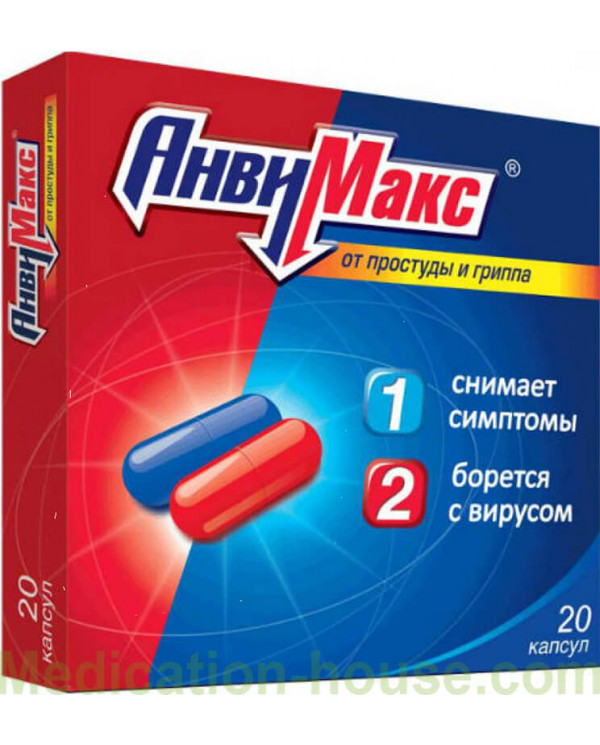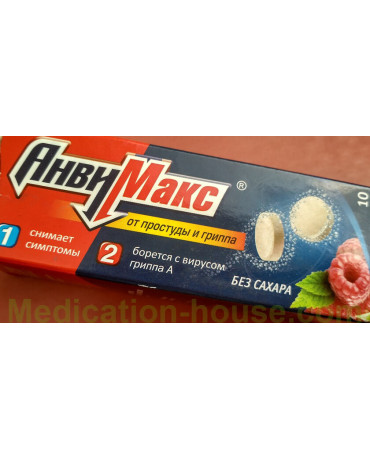Anvimax instruction
You can buy Anvimax here
pharmachologic effect
The combined drug has antiviral, interferonogenic, antipyretic, analgesic, antihistamine and angioprotective effects.
Paracetamol has an analgesic and antipyretic effect.
Ascorbic acid is involved in the regulation of redox processes, promotes normal capillary permeability, blood coagulation, tissue regeneration, plays a positive role in the development of the body's immune responses, and replenishes vitamin C deficiency.
Calcium gluconate, as a source of calcium ions, prevents the development of increased permeability and fragility of blood vessels, causing hemorrhagic processes in influenza and acute respiratory viral infections, has an antiallergic effect (the mechanism is unclear).
Rimantadine has antiviral activity against influenza A virus. By blocking the M2 channels of influenza A virus, it disrupts its ability to penetrate cells and release ribonucleoprotein, thereby inhibiting the most important stage of virus replication. Induces the production of interferons alpha and gamma. In influenza caused by virus B, rimantadine has an antitoxic effect.
Rutoside is an angioprotector. Reduces capillary permeability, swelling and inflammation, strengthens the vascular wall. It inhibits aggregation and increases the degree of deformation of red blood cells.
Loratadine - a blocker of histamine H1 receptors, prevents the development of tissue edema associated with the release of histamine.
Pharmacokinetics
Paracetamol
Suction and distribution
Absorption is high. According to the results of clinical trials, the following pharmacokinetic parameters of paracetamol were established: when using Cmax capsules, paracetamol in plasma is reached after 1.20 ± 0.72 hours and is 5.01 ± 1.70 μg / ml, when using powder - after 0.7 ± 0.39 hours and is 4.79 ± 1.81 μg / ml
Binding to plasma proteins - 15%. Penetrates through the BBB.
Metabolism and excretion
It is metabolized in the liver in three main ways: conjugation with glucuronides, conjugation with sulfates, oxidation with microsomal liver enzymes. In the latter case, toxic intermediate metabolites are formed, which are subsequently conjugated with glutathione, and then with cysteine and mercapturic acid. The main isoenzymes of cytochrome P450 for this metabolic pathway are the isoenzyme CYP2E1 (predominantly), CYP1A2, and CYP3A4 (secondary role). With glutathione deficiency, these metabolites can cause damage and necrosis of hepatocytes. Additional metabolic pathways include hydroxylation to 3-hydroxyparacetamol and methoxylation to 3-methoxyparacetamol, which are subsequently conjugated to glucuronides or sulfates. In adults, glucuronidation predominates. Conjugated paracetamol metabolites (glucuronides, sulfates and conjugates with glutathione) have low pharmacological (including toxic) activity.
It is excreted by the kidneys in the form of metabolites, mainly conjugates, only 3% unchanged. According to the results of clinical trials, T1 / 2 of paracetamol is 3.04 ± 1.01 hours when taking Anvimax in capsules, 2.73 ± 0.76 hours when taking the drug in powder form.
Pharmacokinetics in special clinical cases
In elderly patients, the clearance of Anvimax decreases and T1 / 2 increases.
Vitamin C
Suction and distribution
Absorbed from the gastrointestinal tract (mainly in the jejunum). Gastrointestinal diseases (gastric and duodenal ulcer, constipation or diarrhea, helminthic infestation, giardiasis), the use of fresh fruit and vegetable juices, alkaline drinking reduce the absorption of ascorbic acid in the intestines. The concentration of ascorbic acid in plasma is normally approximately 10-20 μg / ml. The time to reach Cmax in plasma after oral administration is 4 hours.
Binding to plasma proteins - 25%. It easily penetrates into white blood cells, platelets, and then into all tissues; the highest concentration is achieved in the glandular organs, white blood cells, liver and lens of the eye; penetrates the placental barrier. The concentration of ascorbic acid in leukocytes and platelets is higher than in red blood cells and in plasma. In deficient conditions, the concentration in leukocytes decreases later and more slowly and is considered as a better criterion for assessing deficiency than plasma concentration.
Metabolism and excretion
It is metabolized mainly in the liver to deoxy-ascorbic acid and then to oxaloacetic acid and ascorbate-2-sulfate.
It is excreted by the kidneys, through the intestines, with sweat in an unchanged form and in the form of metabolites.
Pharmacokinetics in special clinical cases
Smoking and the use of ethanol accelerate the destruction of ascorbic acid (conversion into inactive metabolites), drastically reducing body reserves.
It is excreted during hemodialysis.
Calcium gluconate
About 1 / 5-1 / 3 of the orally administered calcium gluconate is absorbed in the small intestine; this process depends on the presence of ergocalciferol, pH, dietary features and the presence of factors capable of binding calcium ions. The absorption of calcium ions increases with its deficiency and the use of a diet with a reduced content of calcium ions.
About 20% is excreted by the kidneys, the rest (80%) - by the intestine.
Rimantadine
Suction and distribution
After oral administration, it is almost completely absorbed in the intestine. Absorption is slow. According to the results of clinical trials, the following pharmacokinetic parameters of rimantadine were established: when using Cmax capsules in blood plasma, it is reached after 4.53 ± 2.52 hours and amounts to 68.2 ± 26.6 ng / ml, when using Anvimax in powder form, after 5.28 ± 2.54 hours and is 69 ± 19.7 ng / ml
Plasma protein binding is about 40%. Vd - 17-25 l / kg. The concentration in the discharge from the nose is 50% higher than in plasma.
Metabolism and excretion
Metabolized in the liver. More than 90% is excreted by the kidneys within 72 hours, mainly in the form of metabolites, 15% - unchanged. According to the results of clinical studies, T1 / 2 of rimantadine is 30.51 ± 9.83 hours when using Anvimax in the form of capsules, 33.26 ± 12.76 hours when using the drug in the form of powder.
Pharmacokinetics in special clinical cases
In chronic renal failure, T1 / 2 increases by 2 times. In people with renal failure and in the elderly, rimantadine can accumulate in toxic concentrations if the dose is not adjusted in proportion to a decrease in CC. Hemodialysis has an insignificant effect on the clearance of rimantadine.
Rutoside
The time to reach Cmax in blood plasma after oral administration is 1-9 hours.
It is excreted mainly with bile and to a lesser extent by the kidneys. T1 / 2 - 10-25 hours.
Loratadine
Suction and distribution
Quickly and completely absorbed from the digestive tract. According to the results of clinical studies, the following pharmacokinetic parameters of loratadine were established: when using Anvimax in the form of capsules, Cmax in plasma is reached after 2.92 ± 1.31 hours and is 2.36 ± 1.53 ng / ml, when using the drug in the form of powder - after 3.28 ± 1.25 hours 1.85 ± 0.95 ng / ml.
Binding to plasma proteins - 97%. It does not penetrate the BBB.
Metabolism and excretion
It is metabolized in the liver with the formation of the active metabolite of decarboethoxyloratadine with the participation of cytochrome CYP3A4 isoenzymes and to a lesser extent CYP2D6.
It is excreted by the kidneys and with bile. According to the results of clinical trials, T1 / 2 of loratadine when taking capsules is 12.36 ± 6.84 hours, when using Anvimax in the form of a powder - 11.29 ± 5.52 hours.
Pharmacokinetics in special clinical cases
Cmax in the elderly increases by 50%.
In patients with chronic renal failure and during hemodialysis, the pharmacokinetics are practically unchanged.
Indications for Anvimax
- etiotropic treatment of influenza type A;
- symptomatic treatment of “colds” diseases, flu and SARS, accompanied by fever, muscle pain, headache, chills in adults.
Contraindications
- Hypersensitivity to one or more of the components that make up Anvimax;
- erosive and ulcerative lesions of the gastrointestinal tract in the acute phase;
Gastrointestinal bleeding;
- hemophilia;
- hemorrhagic diathesis;
- hypoprothrombinemia;
- portal hypertension;
- vitamin deficiency K;
- renal failure;
- thyroid disease;
- acute diseases of the kidneys, liver (acute glomerulonephritis, acute pyelonephritis, acute hepatitis), or exacerbation of chronic diseases of these organs;
- chronic alcoholism;
- hypercalcemia, severe hypercalciuria;
- nephrourolithiasis;
- sarcoidosis;
- concomitant use of cardiac glycosides (risk of arrhythmias);
- lactose intolerance, lactase deficiency, glucose-galactose malabsorption;
- phenylketonuria (for powder);
- pregnancy;
- period of breastfeeding;
- children's and teenage age up to 18 years;
With caution, Anvimax should be used and its use limited in case of epilepsy, cerebral atherosclerosis, diabetes mellitus, glucose-6-phosphate dehydrogenase deficiency, hemochromatosis, sideroblastic anemia, thalassemia, hyperoxaluria, urolithiasis, dehydration, electrolyte disturbances, diarrhea syndrome, hypercalmia syndrome malabsorption, calcium nephrourolithiasis (history), hypercalciuria; as well as in elderly patients with arterial hypertension (the risk of developing hemorrhagic stroke increases due to rimantadine, which is part of Anvimax).
Side effects of Anvimax
From the side of the nervous system: increased irritability, drowsiness, tremor, hyperkinesia, dizziness, headache, flushing of the face.
From the digestive system: damage to the mucous membrane of the stomach and duodenum, dyspepsia, dry mucous membrane in the mouth, lack of appetite, flatulence, diarrhea.
From the urinary system: moderate pollakiuria.
From the hematopoietic system: changes in blood counts (control is necessary).
From the endocrine system: inhibition of the function of the insular apparatus of the pancreas (hyperglycemia, glucosuria).
Allergic reactions: skin rash, itching, urticaria.
If any of the side effects indicated in the instructions are aggravated or any other side effects not mentioned in the instructions are noted, the patient should immediately inform the doctor.
Overdose
Symptoms: during the first 24 hours after administration - pallor of the skin, nausea, diarrhea, vomiting, pain in the epigastric region; impaired glucose metabolism, metabolic acidosis, tachycardia, arrhythmia, headache, exacerbation of concomitant chronic diseases. Symptoms of liver dysfunction may appear 12-48 hours after an overdose. In severe overdose - liver failure with progressive encephalopathy, coma; acute renal failure with tubular necrosis (including in the absence of severe liver damage).
Treatment: administration of SH-group donors and precursors of glutathione-methionine synthesis within 8-9 hours after an overdose and acetylcysteine within 8 hours. Gastric lavage, symptomatic therapy. The need for additional therapeutic measures (further administration of methionine, acetylcysteine) is determined depending on the concentration of paracetamol in the blood, as well as on the time elapsed after its administration.
special instructions
Duration of use - no more than 5 days.
Anvimax should not be used in the presence of metastatic tumors.
Patients who abuse alcohol should consult a doctor before starting treatment with Anvimax, since paracetamol can have a damaging effect on the liver.
Influence on the ability to drive vehicles and control mechanisms
During the treatment period, care must be taken when driving vehicles and engaging in other potentially dangerous activities that require an increased concentration of attention and speed of psychomotor reactions.
With renal failure
The use of Anvimax is contraindicated in renal failure, acute kidney disease (acute glomerulonephritis, acute pyelonephritis), or exacerbation of chronic kidney disease, nephrourolithiasis.
With caution, you should use Anvimax with calcium nephrourolithiasis (history).
With impaired liver function
The use of Anvimax is contraindicated in portal hypertension, acute liver disease (acute hepatitis), or exacerbation of chronic liver disease.
Elderly
With caution, Anvimax should be used in elderly patients with arterial hypertension (the risk of developing hemorrhagic stroke increases due to rimantadine, which is part of Anvimax).
Pregnancy and lactation
Use Anvimax during pregnancy and during breastfeeding is contraindicated.
Drug interaction
Paracetamol reduces the effectiveness of uricosuric drugs.
The concomitant use of paracetamol in high doses increases the effect of anticoagulant drugs.
Inducers of microsomal oxidation in the liver (phenytoin, barbiturates, rifampicin, phenylbutazone, tricyclic antidepressants), ethanol and hepatotoxic drugs increase the production of hydroxylated active metabolites, which makes it possible to develop severe intoxications even with a small overdose.
With simultaneous use with metoclopramide, an increase in the rate of absorption of paracetamol is possible.
Prolonged use of barbiturates reduces the effectiveness of paracetamol.
Microsomal oxidation inhibitors reduce the risk of hepatotoxicity.
Rimantadine enhances the stimulating effect of caffeine.
Cimetidine reduces the clearance of rimantadine by 18%.
Ascorbic acid increases the concentration of benzylpenicillin in the blood.
Improves absorption in the intestines of iron preparations (converts ferric to ferrous); may increase iron excretion while used with deferoxamine.
It increases the risk of crystalluria in the treatment of short-acting salicylates and sulfanilamides, slows the excretion of acids by the kidneys, and increases the excretion of drugs with an alkaline reaction (including alkaloids).
Reduces the blood concentration of oral contraceptives.
Increases the total clearance of ethanol, which in turn reduces the concentration of ascorbic acid in the body.
With simultaneous use, it reduces the chronotropic effect of isoprenaline.
Barbiturates and primidone increase urinary excretion of ascorbic acid.
Reduces the therapeutic effect of antipsychotic drugs (antipsychotics) - phenothiazine derivatives.
Reduces tubular reabsorption of amphetamine and tricyclic antidepressants.
Loratadine
CYP3A4 and CYP2D6 inhibitors increase the concentration of loratadine in the blood.
Mode of application
Anvimax is taken orally after a meal. Capsules should be washed down with water. The powder (contents of 1 sachet) must be dissolved in 1/2 cup of warm boiled water and stirred. The resulting solution should be consumed immediately after preparation.
Adults are prescribed 1 capsule P of blue color and 1 capsule P of red color (single dose) or 1 sachet of powder 2-3 times / day.
Anvimax should be taken within 3-5 days (no more than 5 days) until the symptoms of the disease disappear. If there is no improvement in well-being, the patient should stop using Anvimax and consult a doctor.
Storage conditions and shelf life
Anvimax should be stored out of the reach of children, dry, protected from light at a temperature of no higher than 25 ° C. The shelf life of the capsules is 2 years, the powder for the preparation of a solution for oral administration is 30 months.
Terms of sell
You can buy Anvimax without a prescription.




